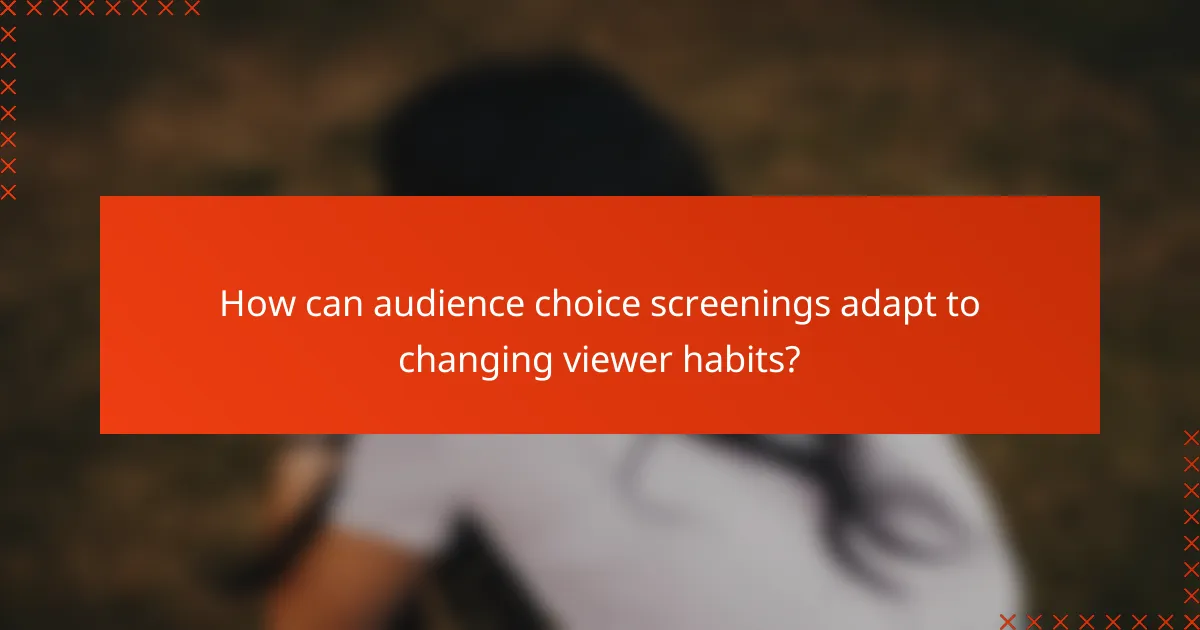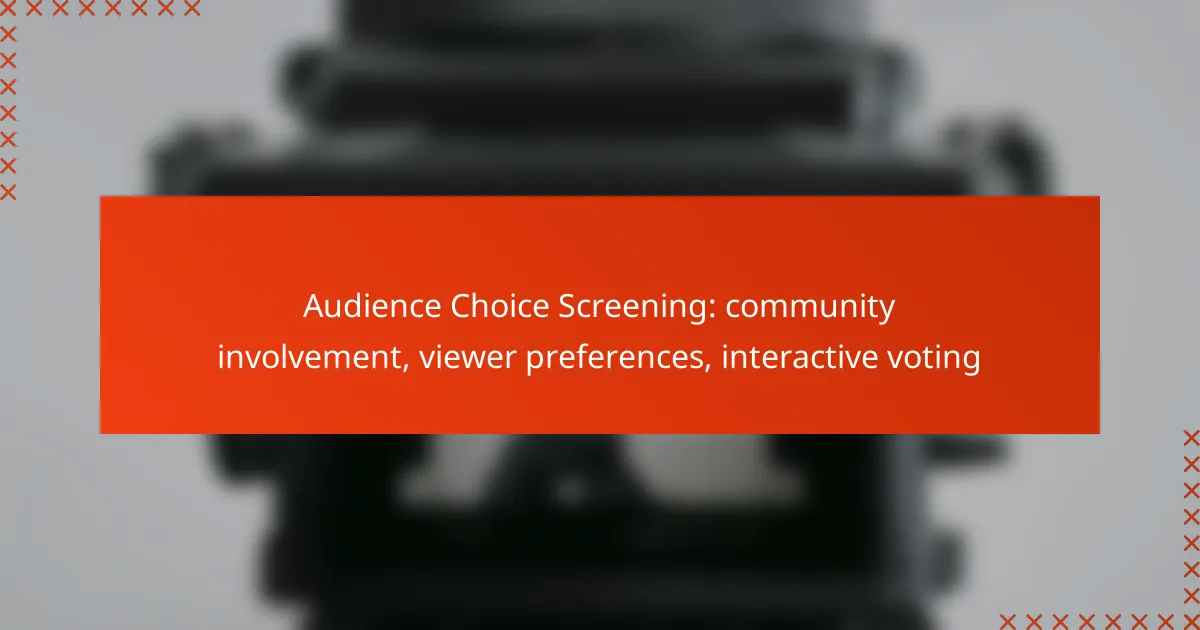Audience choice screenings thrive on community involvement, allowing viewers to feel a deeper connection to the films presented. By engaging local audiences in the selection process through interactive voting, these screenings not only reflect viewer preferences but also enhance attendance and create a more personalized experience. This dynamic approach ensures that the films resonate with the community’s values and interests, fostering a vibrant cultural dialogue.

How does community involvement enhance audience choice screenings in Australia?
Community involvement significantly enhances audience choice screenings in Australia by fostering a sense of ownership and connection among viewers. Engaging local audiences in the selection process not only boosts attendance but also ensures that the films resonate with the community’s preferences and values.
Increased engagement through local events
Local events centered around audience choice screenings create a vibrant atmosphere that encourages community participation. These events often include pre-screening discussions, meet-and-greets with filmmakers, and interactive activities that draw in diverse groups of people.
For example, hosting screenings in parks or community centers can attract families and individuals who may not typically attend traditional cinemas. This approach can lead to increased ticket sales and a stronger community bond.
Collaborative decision-making with community groups
Collaborative decision-making involves partnering with local organizations, schools, and cultural groups to identify films that reflect the community’s interests. By involving these groups, organizers can ensure that the chosen films align with local values and preferences.
Additionally, using platforms for interactive voting allows community members to express their preferences easily. This not only empowers viewers but also creates a more inclusive environment where everyone feels their voice matters in the selection process.

What are viewer preferences in audience choice screenings?
Viewer preferences in audience choice screenings reflect the genres and themes that resonate most with the audience, influencing the selection of films shown. These preferences are shaped by various factors, including cultural trends, social media interactions, and community engagement.
Popular genres among Australian audiences
In Australia, popular genres often include drama, comedy, and thriller, with a growing interest in documentaries and local productions. Audiences tend to favor films that reflect their cultural experiences or offer relatable narratives.
Community screenings can benefit from understanding these preferences, as selecting films that align with popular genres can enhance attendance and engagement. For instance, showcasing Australian-made films can attract viewers who want to support local talent.
Influence of social media on viewer choices
Social media plays a significant role in shaping viewer choices for audience choice screenings. Platforms like Facebook, Instagram, and Twitter allow audiences to express their preferences and vote for films, creating a more interactive experience.
Engagement through social media can increase excitement and anticipation for screenings. Film organizers should consider leveraging these platforms to promote voting campaigns, share trailers, and gather feedback, ensuring that the selected films align with audience interests.

How does interactive voting work in audience choice screenings?
Interactive voting in audience choice screenings allows viewers to actively participate in selecting films or content by casting their votes in real-time. This process enhances community involvement and aligns the screening with viewer preferences, making the experience more engaging and personalized.
Real-time voting mechanisms
Real-time voting mechanisms enable audiences to submit their choices instantly during a screening. Common methods include mobile apps, SMS voting, and web-based platforms that display live results. These systems often ensure that votes are counted quickly, typically within seconds to a few minutes, allowing for immediate feedback on audience preferences.
To implement effective real-time voting, organizers should consider user-friendly interfaces and clear instructions. Avoid technical jargon and ensure that all participants can easily understand how to cast their votes. This clarity can significantly increase participation rates.
Platforms for audience participation
Several platforms facilitate audience participation through interactive voting. Popular options include dedicated event apps, social media integrations, and polling websites. Each platform has its strengths; for instance, event apps may offer more tailored features, while social media can reach a broader audience quickly.
When choosing a platform, consider factors such as accessibility, user engagement features, and data security. Ensure that the platform complies with local regulations regarding data privacy, especially if collecting personal information from participants. A well-selected platform can enhance the voting experience and foster a sense of community among viewers.

What are the benefits of audience choice screenings for filmmakers?
Audience choice screenings provide filmmakers with valuable insights into viewer preferences, enabling them to tailor their projects more effectively. By engaging the audience in the selection process, filmmakers can enhance their connection with viewers and increase the likelihood of commercial success.
Direct feedback from viewers
Direct feedback from viewers allows filmmakers to understand audience reactions and preferences in real-time. This feedback can be gathered through surveys or interactive voting platforms, giving filmmakers specific insights into what resonates with their audience.
For example, if a particular scene or character receives positive feedback, filmmakers can consider expanding on those elements in future projects. Conversely, negative feedback can highlight areas needing improvement, guiding filmmakers in refining their storytelling techniques.
Increased ticket sales through targeted content
By incorporating audience preferences into their content, filmmakers can significantly boost ticket sales. When viewers feel involved in the decision-making process, they are more likely to attend screenings of films they helped choose.
Targeted content can be achieved by analyzing voting patterns and preferences, allowing filmmakers to create films that align with audience interests. This approach not only increases attendance but can also enhance word-of-mouth promotion, further driving ticket sales.

What criteria should be considered for selecting films in audience choice screenings?
Key criteria for selecting films in audience choice screenings include audience demographics, viewer preferences, and current trends in film festivals. Understanding these factors helps ensure that the chosen films resonate with the audience and enhance community involvement.
Audience demographics and preferences
When selecting films, it’s crucial to consider the demographics of the audience, such as age, cultural background, and interests. Different age groups may prefer varying genres, with younger audiences often gravitating towards contemporary themes and older viewers favoring classic narratives.
Viewer preferences can be gauged through surveys or past attendance data, helping to identify popular genres or specific films that have previously engaged the community. This information allows organizers to curate a lineup that reflects the tastes and interests of the audience.
Film festival trends in Australia
In Australia, film festival trends indicate a growing interest in diverse storytelling and local productions. Recent festivals have showcased a mix of international films alongside Australian narratives, highlighting the importance of cultural representation.
Additionally, interactive voting has become a popular feature, allowing audiences to influence the selection process. This engagement not only increases attendance but also fosters a sense of ownership among viewers, making them more likely to participate in future screenings.

How do audience choice screenings impact community culture?
Audience choice screenings significantly enhance community culture by actively involving local viewers in the selection of films. This engagement fosters a sense of ownership and pride, leading to a more vibrant cultural landscape.
Fostering local talent and storytelling
Audience choice screenings provide a platform for local filmmakers to showcase their work, allowing unique stories from the community to be told. This exposure can lead to increased opportunities for local talent, as viewers often seek out more films from their favorite local creators.
By prioritizing local narratives, these screenings encourage filmmakers to explore themes relevant to their communities, enhancing the richness of the storytelling. This can result in a diverse array of films that reflect the unique experiences and perspectives of the area.
Building community identity through shared experiences
Shared experiences during audience choice screenings help to strengthen community identity by bringing people together around common interests. When viewers vote for films, they engage in a collective decision-making process that fosters connections among attendees.
These events often serve as social gatherings, where discussions about the films can lead to deeper conversations about community values and issues. This interaction not only enhances the viewing experience but also cultivates a sense of belonging and unity among community members.

What are emerging trends in audience choice screenings?
Emerging trends in audience choice screenings include innovative technologies and data-driven approaches that enhance viewer engagement and participation. These trends focus on integrating immersive experiences and leveraging audience insights to tailor content selection.
Integration of virtual reality experiences
Virtual reality (VR) experiences are increasingly being incorporated into audience choice screenings to create immersive environments. By allowing viewers to engage with content in a three-dimensional space, organizers can enhance emotional connections and overall enjoyment.
For example, a film festival might offer VR previews of selected films, enabling audiences to experience key scenes before voting. This approach not only boosts excitement but also provides a unique way for viewers to express their preferences.
Use of data analytics for audience insights
Data analytics plays a crucial role in understanding audience preferences during choice screenings. By collecting and analyzing viewer data, organizers can identify trends and tailor their offerings to better meet audience expectations.
For instance, analyzing voting patterns can reveal which genres or themes resonate most with viewers. This information can guide future programming decisions, ensuring that screenings align with audience interests and maximize attendance.

How can audience choice screenings adapt to changing viewer habits?
Audience choice screenings can adapt to evolving viewer habits by incorporating interactive voting and community engagement strategies. These adaptations allow organizers to better align film selections with viewer preferences and foster a sense of ownership among attendees.
Engaging the Community
Engaging the community is crucial for successful audience choice screenings. Organizers can host pre-screening events or discussions to gather input on film selections, creating a platform for local voices. This involvement not only enhances viewer investment but also strengthens community ties.
Consider utilizing social media polls or local forums to gauge interest in potential films. This approach allows for a broader range of opinions and can lead to more diverse programming that reflects the community’s tastes.
Implementing Interactive Voting
Interactive voting can significantly enhance the audience choice experience. By using apps or online platforms, viewers can vote on films in real-time, making the screening more dynamic and engaging. This method also provides immediate feedback on viewer preferences.
For example, a cinema could set up a voting system where attendees select their preferred film from a shortlist. This can be done before the event or even during the screening, allowing for spontaneous choices based on audience mood.
Adapting to Viewer Preferences
Adapting to viewer preferences requires continuous monitoring of trends and feedback. Organizers should analyze past screening data and audience surveys to identify popular genres or themes. This information can guide future selections, ensuring they resonate with the audience.
Regularly updating the film selection process based on viewer feedback can lead to higher attendance and satisfaction rates. Consider implementing a feedback loop where attendees can share their thoughts after each screening, helping to refine future choices.



